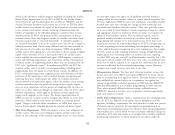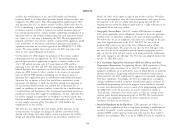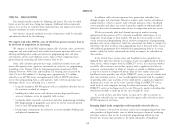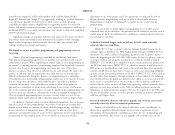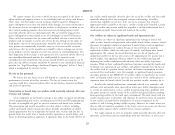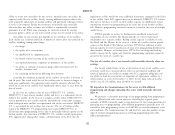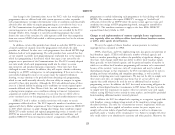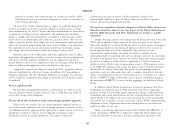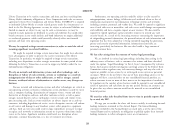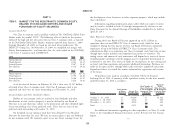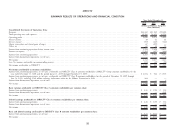DIRECTV 2010 Annual Report Download - page 44
Download and view the complete annual report
Please find page 44 of the 2010 DIRECTV annual report below. You can navigate through the pages in the report by either clicking on the pages listed below, or by using the keyword search tool below to find specific information within the annual report.DIRECTV
ability to attract new subscribers for our services. Anomalies may also reduce the replacement satellite would not cause additional interference compared to the failed
expected useful life of a satellite, thereby creating additional expenses due to the or lost satellite. Such FCC approval may not be obtained. DIRECTV U.S. believes
need to provide replacement or backup satellites and potentially reducing revenues they have or will have in 2011, in-orbit satellite capacity to expeditiously recover
if service is interrupted. Finally, the occurrence of anomalies may materially transmission of most our programming in the event one of our in-orbit satellites
adversely affect our ability to insure our satellites at commercially reasonable fails. However, programming continuity cannot be assured in the event of multiple
premiums, if at all. While some anomalies are currently covered by existing satellite losses.
insurance policies, others are not now covered or may not be covered in the future. DTVLA provides its services in PanAmericana and Brazil using leased
Our ability to earn revenue also depends on the usefulness of our satellites. transponders on two satellites. Sky Mexico provides its services from leased
Each satellite has a limited useful life. A number of factors affect the useful life of a transponders on a separate satellite. Backup satellite capacity is available to serve
satellite, including, among other things: Sky Brazil and Sky Mexico. In the event of a failure of a satellite used to provide
services to Sky Brazil or Sky Mexico, we believe DTVLA has sufficient in orbit
• the design; back-up capacity to recover transmission of most of its programming distributed in
• the quality of its construction; those markets. However, in PanAmericana, DTVLA has no designated back up
satellite capacity for the region and, therefore, programming continuity cannot be
• the durability of its component parts; assured in the event of a satellite loss.
• the launch vehicle’s insertion of the satellite into orbit;
The loss of a satellite that is not insured could materially adversely affect our
• any required movement, temporary or permanent, of the satellite; earnings.
• the ability to continue to maintain proper orbit and control over the Any launch vehicle failure, or loss or destruction of any of our satellites, even
satellite’s functions; and if insured, could have a material adverse effect on our financial condition and
• the remaining on-board fuel following orbit insertion. results of operations, our ability to comply with FCC regulatory obligations and
our ability to fund the construction or acquisition of replacement satellites in a
Generally, the minimum design life of the satellites in our fleet is between 12 timely fashion, or at all. At December 31, 2010, the net book value of in-orbit
and 16 years. The actual useful lives of the satellites may be shorter or longer, in satellites was $2,165 million, none of which was insured.
some cases significantly. Our operating results could be adversely affected if the
useful life of any of our satellites were significantly shorter than 12 years from the We depend on the Communications Act for access to cable-affiliated
date of launch. programming and changes impacting that access could materially adversely
In the event of a failure or loss of any of DIRECTV U.S.’ satellites, affect us.
DIRECTV U.S. may relocate another satellite and use it as a replacement for the We purchase a substantial percentage of our programming from programmers
failed or lost satellite. In the event of a complete satellite failure, DIRECTV U.S.’ that are affiliated with cable system operators, including key regional sports
services provided via that satellite could be unavailable for several days or longer networks, or RSNs. Currently, under certain provisions of the Communications Act
while backup in-orbit satellites are repositioned and services are moved. DIRECTV governing access to programming, cable-affiliated programmers generally must sell
U.S. is not insured for any resultant lost revenues. The use of backup satellite and deliver their programming services to all MVPDs on non-discriminatory terms
capacity for DIRECTV U.S. programming may require DIRECTV U.S. to and conditions. The Communications Act and the FCC rules also prohibit certain
discontinue some programming services due to potentially reduced capacity on the types of exclusive programming contracts involving programming from cable-
backup satellite. Any relocation of DIRECTV U.S.’ satellites would require prior affiliated programmers.
FCC approval and, among other things, a demonstration to the FCC that the
22


